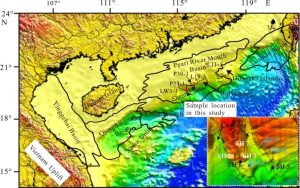
Credit: ©Science China Press
Natural gas hydrates are clathrate hydrates that consist of water molecules and natural gas molecules (major constituent: methane). They are mainly distributed along continental slopes of the oceans or permafrost regions on land. Highly saturated hydrate reservoirs may be ideal alternative energy resources, which makes them an important target area for the exploitation and utilization of natural gas hydrates. Influenced and restricted by the grain size of the sediments, natural gas hydrates are mainly found in the coarse sands, while in fine-grained sediments, the hydrate rarely occurs, or the saturation of the gas hydrates would be relatively low. However, among drilling projects in 2007 in the Shenhu area, South China Sea (SCS), the average sand content in the hydrate reservoir was only around 1.4 to 4.24 percent, and the hydrate saturation was as high as 20 to 40 percent. While related to the supply of gas sources and tectonic activities, this result may also be attributed to the abundant foraminifera shells in the SCS sediments
The samples used in this study were obtained from the Shenhu area, SCS, and provided by Guangzhou Marine Geological Survey during voyage HY-2006-3. It was located in E 115°12.52363?N 19°48.40299? where the water depth is 1,554 meters. The seafloor sediments were collected with gravity piston core. Although these samples did not contain natural hydrates, they were obtained near the location where hydrate samples were drilled in 2007 (Figure 1). Because the geological backgrounds between these two kinds of samples were basically the same, the samples analyzed in this study are considered as representative of sediments of the hydrate reservoir.
About 10 g SCS samples were dispersed in water, and the foraminifera shells in the samples were selected and divided into three groups by size (greater than 150μm, 63-150μm, less than 63μm). The abundance of foraminifera in the SCS sediments was relatively high, and almost all the foraminifera were planktonic. In addition, most of the foraminifera is coarse-grained (greater than 150 μm).
Surface and inner structures of the foraminifera shells selected from the SCS sediments were studied by SEM and X-ray CT. The foraminifera shells displayed as a single sphere or multi-chamber structure. The surfaces of the shells showed numerous micropores (six to eight μm), among which some pores were filled with sediments, while most connected the chambers of the shells to the outside space. Most foraminifera shells have effective pore space providing an ideal place for hydrate growth and accumulation. It can also partially explain the high saturation of hydrate in the fine-grained SCS sediments. By statistically analyzing the number of voxels within the grayscale range that represented the inner pores of the foraminifera in the region, the effective volume of pores inside the foraminifera was up to 18.5 percent of the total volume, which indicates that the presence of foraminifera shells increases the porosity of the SCS sediments effectively.
The SCS sediments consisted primarily of silt and sand, and the pores between different grains were tiny and filled with clays. Because of the limited image resolution, only the hydrate distribution in the foraminifera chambers (pores inside the grains) could be observed; in turn, so it was difficult to identify tiny hydrate crystals dispersed between fine grains of the sediments in CT images. The hydrates grew inside the foraminifera. The volume of the hydrates was greater than the corresponding liquid volume. Before the formation of hydrates, only a small amount of water was present inside some foraminifera shells. With hydrates accumulating over time, the liquid and methane gas mitigated toward the inner space of the foraminifera shells via the mouth and the micropores in the shell walls. Except in some of the foraminifera shells filled with other materials, hydrates contacted with the inner walls of the foraminifera shells directly.
Reference:
ChengFeng Li et al, Influence of foraminifera on formation and occurrence characteristics of natural gas hydrates in fine-grained sediments from Shenhu area, South China Sea, Science China Earth Sciences (2016). DOI: 10.1007/s11430-016-5005-3
Note: The above post is reprinted from materials provided by Science China Press.










